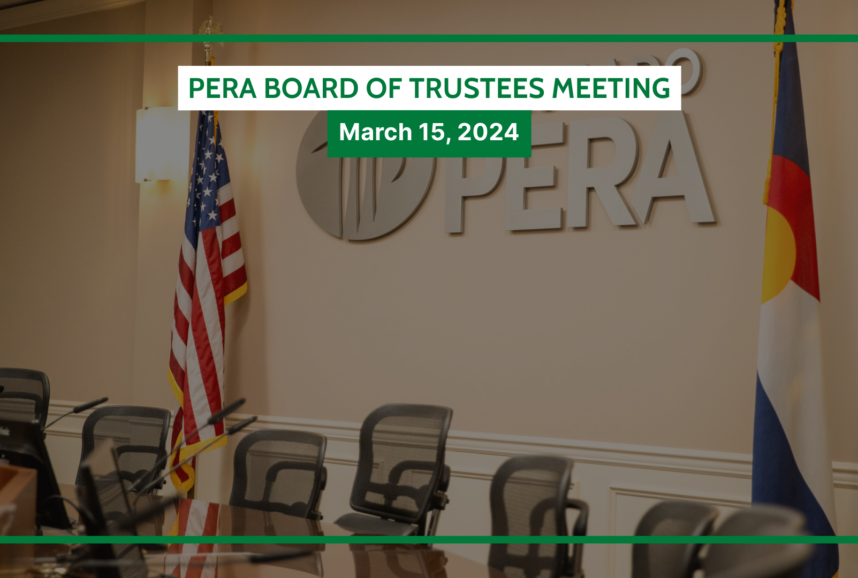PERA’s Trustees – the 16 professionals who oversee PERA’s investment program and benefits administration – are each bound by a set of fiduciary responsibilities requiring them to act in the best interest of PERA members and retirees.
As fiduciaries, Trustees have duties of loyalty, care, and prudence to act in the best interest of another party, acting “solely in the interest of his or her client” and “perform with a high level of competence and thoroughness, in accordance with industry standards.” Colorado law makes it clear that PERA fiduciaries have a responsibility to “carry out their functions solely in the interest of members and benefit recipients and for the exclusive purpose of providing benefits.” (C.R.S. § 24-51-207(2)(a)).
Both PERA employees and PERA Trustees receive regular training on what it means to be a fiduciary and the legal and ethical standards involved in fulfilling their roles.
In addition to attending extensive education and training to prepare them for their role, Trustees participate in five regular board meetings each year as well as committee meetings and, potentially, special meetings to review and consider proposed legislation that could impact PERA.
While only the Colorado General Assembly has the authority to make changes to the PERA benefit and contribution structure, as fiduciaries, PERA Trustees play an important role in the administrative oversight of PERA and have the responsibility to set the actuarial assumptions used by the plan, including the long-term rate of return assumption. Trustees have access to world-class consulting firms to assist them in setting the assumptions (both demographic and economic) used in the measurement of the financial health of the system.
Setting the long-term rate of investment return – a case study
Economic assumptions used by PERA include price inflation, wage inflation, and the long-term investment rate of return. The long-term rate of return assumption is the most powerful of all the assumptions therefore it receives a lot of attention.
How does the Board determine what rate of return will be used?
In October 2016, the Board conducted an Actuarial Assumption Workshop. The purpose of the workshop was to review economic and demographic information and receive presentations from actuarial and investment professionals. The process began prior to the workshop when Trustees received:
- Economic and market data analysis. Ahead of the workshop, as it relates to the rate of return, materials provided to the Board included economic and market data compiled by the Board’s Investment Consultant (Aon Hewitt), and detailed investment and funded ratio history compiled by PERA staff.
- Economic forecasts. The Board also received information from the International Monetary Fund, the Congressional Budget Office, The World Bank, Bloomberg, the McKinsey Global Institute, and Moody’s Investor Services.
- Public pension fund research. This data was further informed by information from the National Association of State Retirement Administrators (NASRA) including the NASRA Public Fund Survey, and economic information from the U.S. Bureau of Labor Statistics, the Federal Reserve, the U.S. Census Bureau, as well as an overview of the investment rate of return assumptions used by public plans in the U.S.
At the workshop, key activities included:
- Investment professional presentations. Presentations from an economist from Goldman Sachs and the Vice Chairman of Blackstone.
- Capital market analysis. Aon Hewitt provided a capital market analysis
- Actuarial analysis. The Board’s actuarial consultant (Cavanaugh Macdonald Consulting, LLC) presented the results of their analysis of future returns based on the capital market assumptions provided by Aon Hewitt. The Board also reviewed a presentation by Xerox (formerly Buck Consultants) which projected investment returns based on a proprietary model.
Following the workshop, at the November 2016 Board meeting, the Board adopted the following economic assumptions for the 2016 valuation:
- Price Inflation – 2.4%
- Investment Return – 7.25%
- General Wage Growth – 3.5%
- Wage Inflation – 1.1%
- Total Salary Increase – Adjust all ages and divisions by 0.40% for decrease in general wage growth.
These assumptions are still in place today. As a leading public retirement plan, PERA conducts regular experience studies and examines its assumptions on a regular basis.
FiduciaryA person who manages money on someone else’s behalf and who has a sworn responsibility to manage those funds in the best interest of the client. Actuarial assumptionData such as demographics, mortality rates, and investment returns that retirement plans use to calculate future assets and liabilities.





Respectfully,
From my perspective, your role as described in this article, should be driving you to represent the benefit recipients’ interest to keep retirees’ benefits consistent with the rate of inflation rather than suggesting a reduction in the Cap on the COLA. PERA recommendations to eliminate COLAs in 2018-19, and then cut the Cap, as proposed in SB 18-200, will diminish the interests of current benefit recipients.
The legislature has the ultimate authority to decide what adjustments will be made in order to protect PERA’s long term solvency. The legislators and Governor are more than capable of initiating actions on their own motion to attempt to diminish our financial well being without your help. You could have proposed only employer increases and left it to them to be the bad guys regarding COLAs and member contributions. Instead you gave cover to those who do not have retirees’ and members’ best interests at heart.
Your role as described in this article does not indicate you have a responsibility to the employer. To the contrary, it is specific to the interests of the members and benefit recipients. Therefore, your recommendations should always be directed toward preserving what retirees and members currently have rather than offering to give it away.
The employer should be obligated to preserve the long term solvency of the fund for benefit recipients and members. The PERA trustees and PERA as a whole should stick to the obligation to monitor PERA’s investment program and benefits administration.
Please practice what you cited above, “…carry out their functions solely in the interest of members and benefit recipients and for the exclusive purpose of providing benefits.” (C.R.S. § 24-51-207(2)(a)).